It has become a long-standing tradition that with almost every GPU generation, Nvidia does something misleading, anti-consumer, or borderline deceptive. If you thought that almost two years into the GeForce 40 series, they would break this tradition, you were clearly mistaken.
But what do we mean by this? Let’s go back and take the much-loved GeForce 10 series as an example. Many are quite fond of parts like the GTX 1080 and 1080 Ti. However, as good as those high-end models were, Nvidia found a way to undercut budget gamers with the infamous DDR4 version of the GT 1030.
The GeForce GT 1030 was released in May 2017 with 2GB of GDDR5 memory. It was a modest product by all accounts, and with just 48 GB/s of memory bandwidth, it was no powerhouse. Still, it was usable, and at just $70, it wasn’t exactly expensive.
But a year after its release, Nvidia pulled one of the most egregious bait-and-switches the GPU market had ever seen. They began arming some GT 1030s with desktop DDR4 memory, reducing the memory bandwidth to a mere 16.8 GB/s.
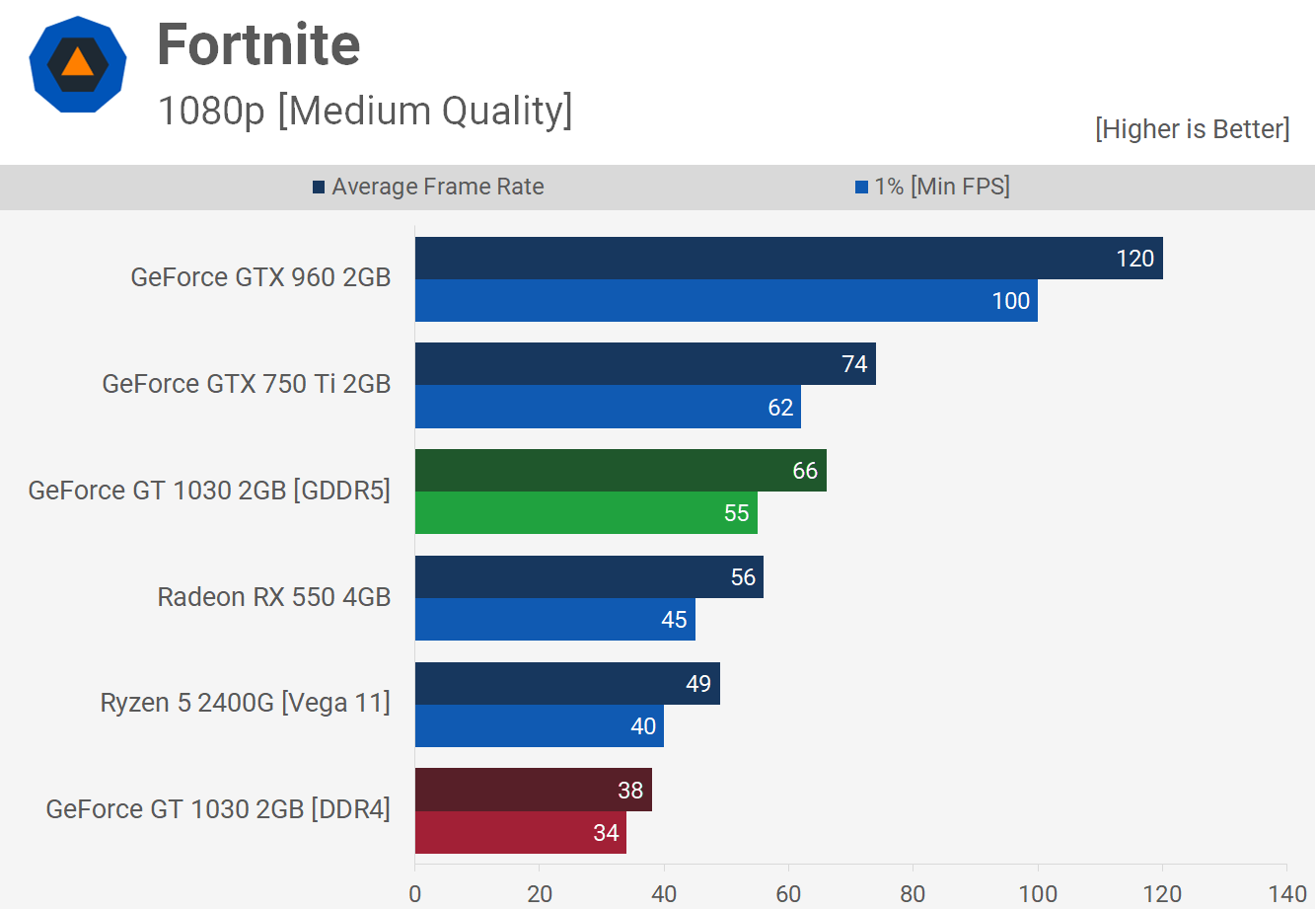
It became extremely difficult for buyers to determine which model they were getting, and worse still, most didn’t even know there were two models, as both were simply called the GT 1030. In short, the DDR4 version was, on average, 40% slower for the same price – it was insane.
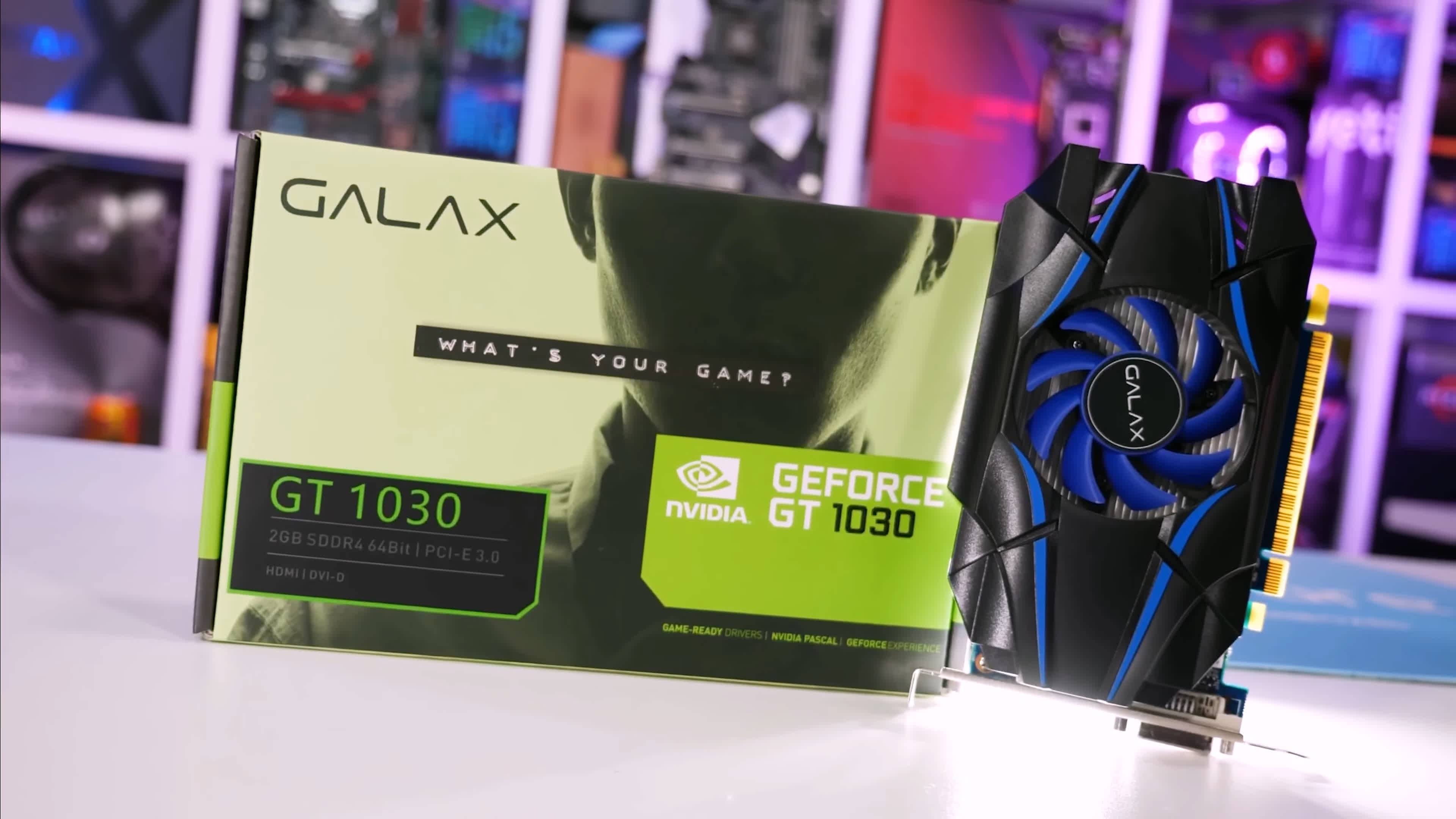
There was a reasonable amount of backlash, but that didn’t stop Nvidia. While they kept things relatively legitimate for the Turing generation (RTX 20 / GTX 16 series), we still saw models with multiple variants under the same name.
It wasn’t until Ampere, the GeForce 30 series, that Nvidia fully reverted to its old tactics, releasing multiple models under the same name. The quietly released follow-up models were often worse than the original versions.
For instance, Nvidia released the 8GB version of the RTX 3060 a year and a half after the original 12GB version. The 12GB model came with GDDR6 using a 192-bit wide memory bus for a bandwidth of 360GB/s. The new 8GB version, however, was forced to reduce its bus width to 128-bit, slashing the bandwidth by 33% to just 240GB/s, and as a result, it was often much slower.
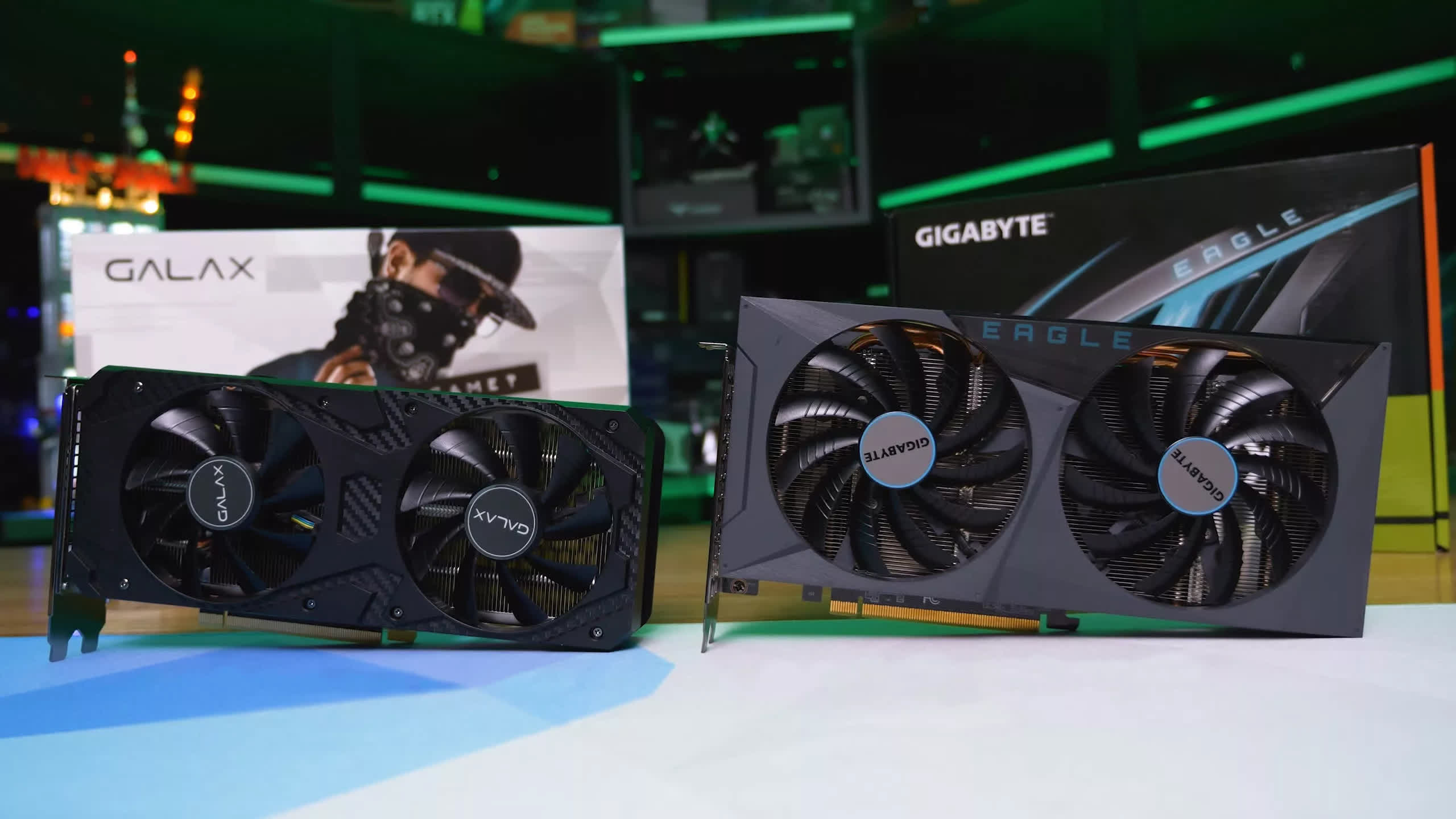
Both models were called the “GeForce RTX 3060,” but the 8GB version was, on average, 15% slower, with instances where it was up to 26% slower. To make matters worse, the 8GB model was typically only about 5% cheaper, despite offering, on average, 15% worse performance. So, in terms of value, the 8GB model was a poor deal.
The real issue, however, was that most people didn’t even know there were two versions of the same product. When they researched RTX 3060 performance, they were almost certainly looking at benchmarks for the 12GB model, but when it came time to purchase, they might have ended up with the 8GB version, unknowingly making a poor choice.
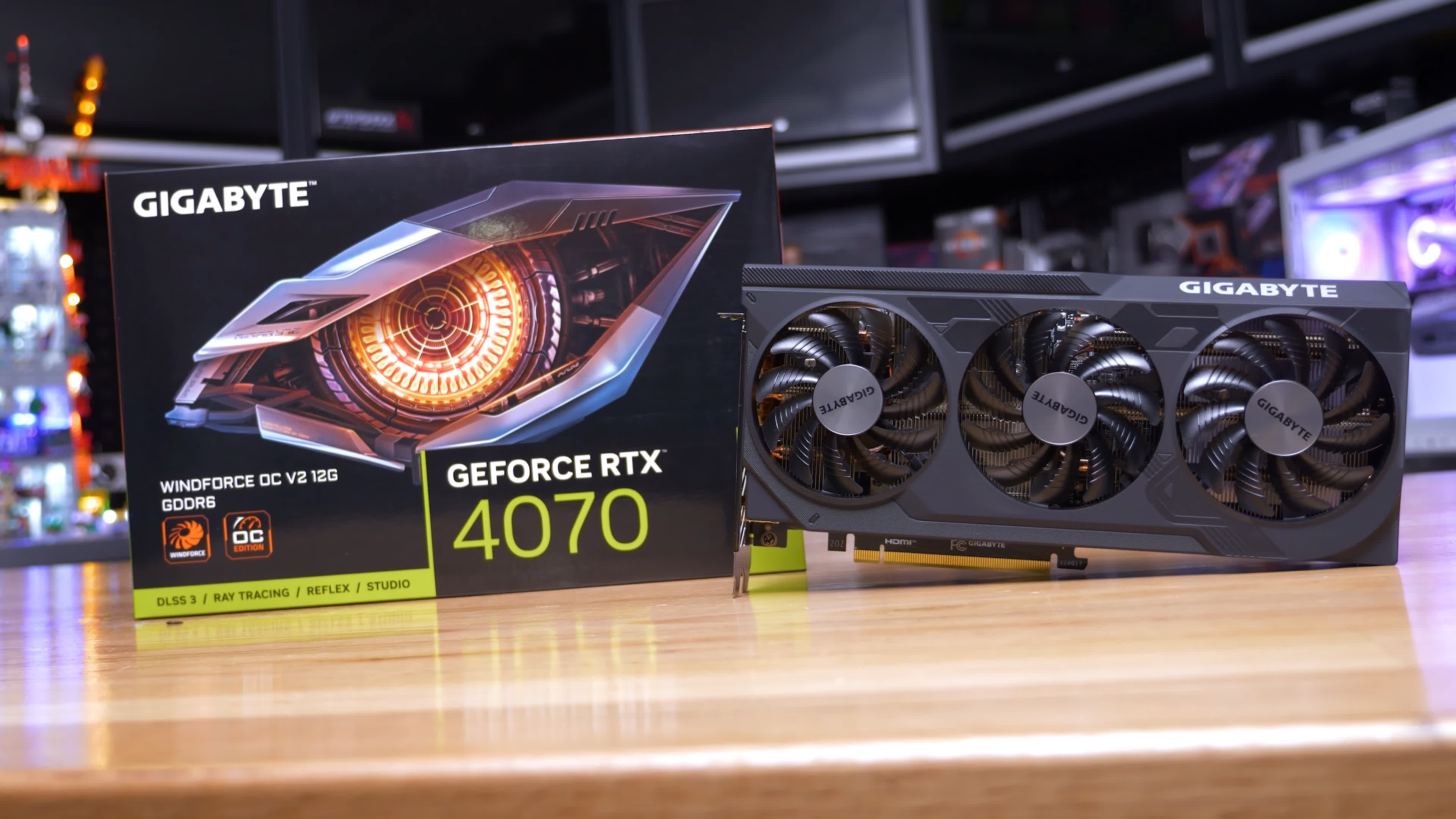
Now, we arrive at the GeForce 40 series. Despite a few lackluster products, such as the $400 RTX 4060 Ti 8GB and the $500 16GB model (though it eventually saw a slight discount), this series had been relatively free from shady practices – until now. Nvidia has quietly released a new version of the GeForce RTX 4070, and while the downgrade is minor, the price remains unchanged.
For those unaware, Nvidia launched the GeForce RTX 4070 for $600 about a year and a half ago. It featured 12GB of GDDR6X 21Gbps memory, resulting in a memory bandwidth of 504GB/s. At launch, it was considered one of the better products in the GeForce 40 series, and while we weren’t blown away, it offered decent value at $600.
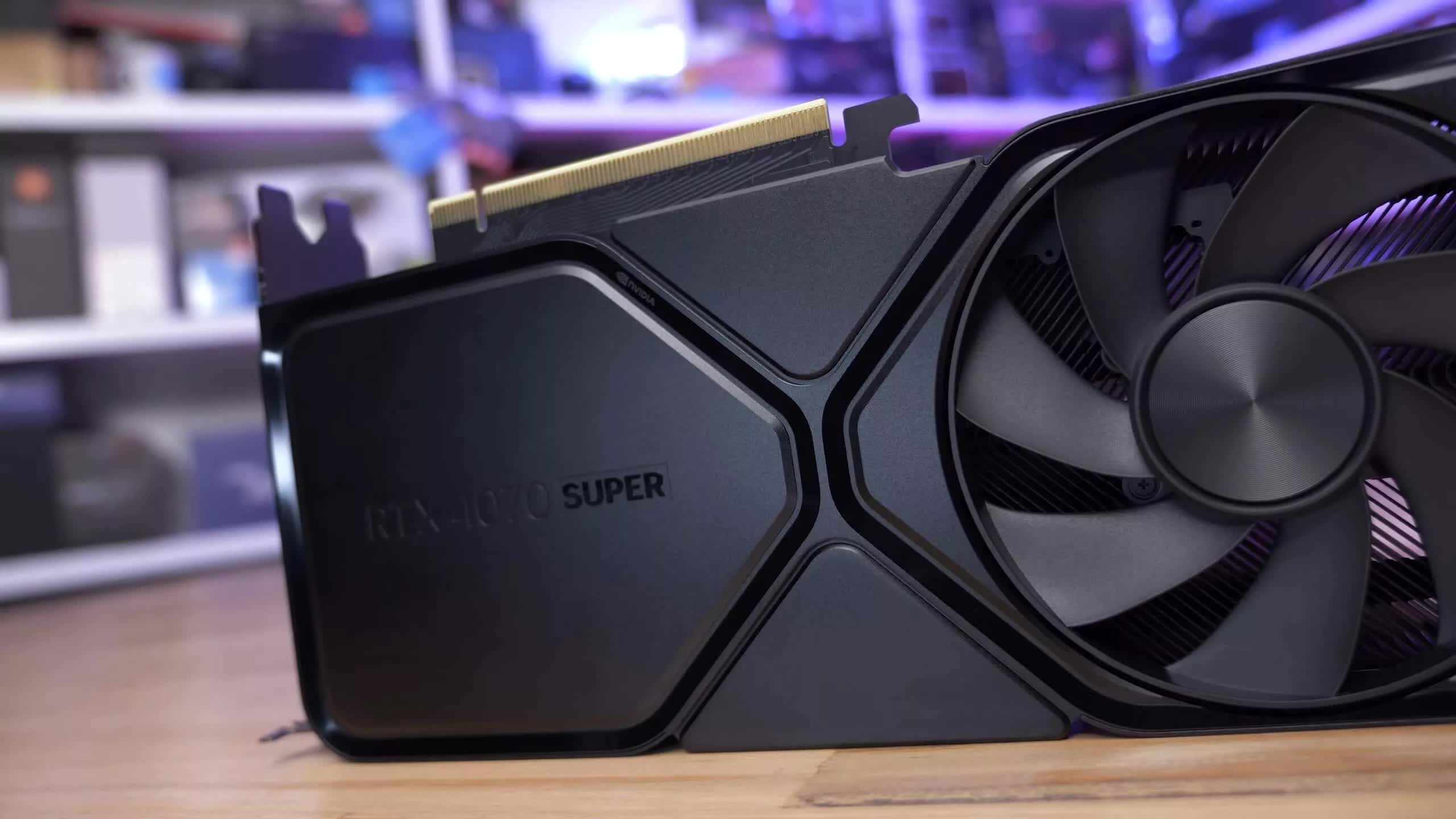
Since then, the RTX 4070 Super has taken its place at the $600 price point, with the original 4070 dropping to $550 – a $50 discount. However, potential RTX 4070 buyers now face a new problem: the model they purchase might not come with GDDR6X memory.
Quietly announced late last month, GDDR6 models have started appearing on shelves, so we purchased one for $900 Australian – the same price as the GDDR6X model. The good news is that this version has only been downgraded slightly, with 20Gbps memory, reducing the memory bandwidth to 480GB/s – a 5% reduction. This won’t drastically impact performance, but it is still a downgrade, and the product name remains the same.
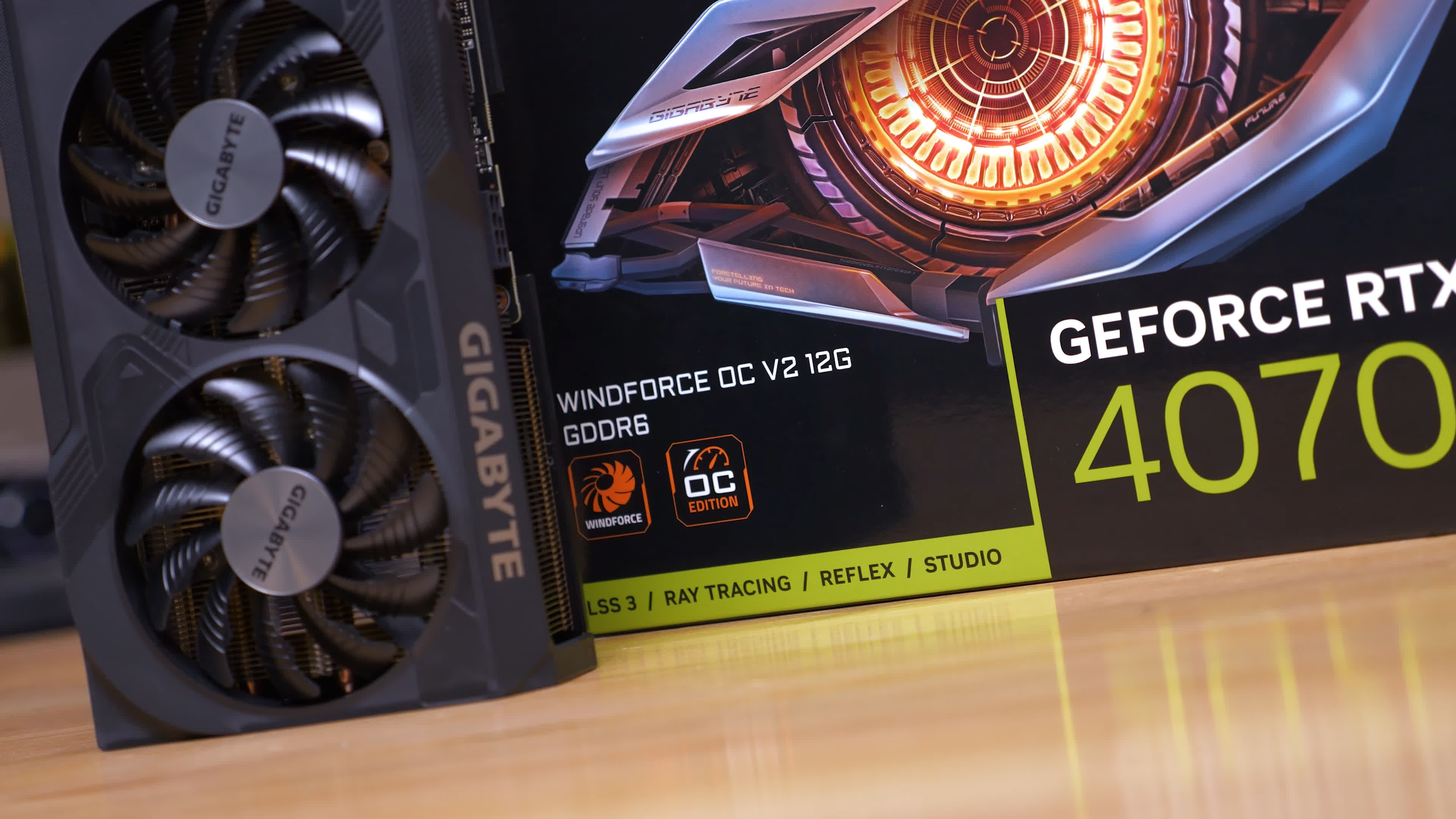
The truth is, the vast majority of consumers don’t know whether the RTX 4070 is supposed to come with GDDR6 or GDDR6X memory. And without looking it up, most people wouldn’t know either. After all, why should they? Consumers trust that they are getting what Nvidia advertised a year and a half ago, but sadly, that’s no longer the case.
Test Setup
| CPU | AMD Ryzen 7 7800X3D |
| Cooling | be quiet! Pure Loop 2 FX 360mm |
| Motherboard | Gigabyte X670E Aorus Master [BIOS F32b] |
| Memory | G.Skill Trident Z5 RGB 32GB DDR5-6000 [CL30-38-38-96] |
| ATX Case | MSI Prospect 700R |
| Power Supply | Kolink Regulator Gold ATX 3.0 1200W |
| Storage | TeamGroup T-Force Cardea A440 M.2 PCle 4 NVMe SSD 4TB |
| Operating System | Windows 11 |
| Display Driver | Nvidia Game Ready Driver 560.94 |
| AMD Adrenalin Edition 24.10.37.10 |
So let’s see how the GDDR6 version compares to the GDDR6X model with some gaming benchmarks. As usual, we will be testing with our AMD Ryzen 7 7800X3D system, and we’ve updated the results for both RTX 4070 models.
The original RTX 4070 results are based on the Founders Edition model, which is clocked just slightly lower than the Gigabyte Windforce OC GDDR6 version we purchased, so core clock speeds are essentially the same. The key difference here is the memory speed, which drops from 21Gbps to 20Gbps.
Let’s check out the results…
Benchmarks
Cyberpunk 2077
We won’t spend too much time on this data, as it’s mainly to validate the performance changes. We’ll go over a few individual games at 1440p and then check out the 12-game average data at 1080p, 1440p, and 4K.
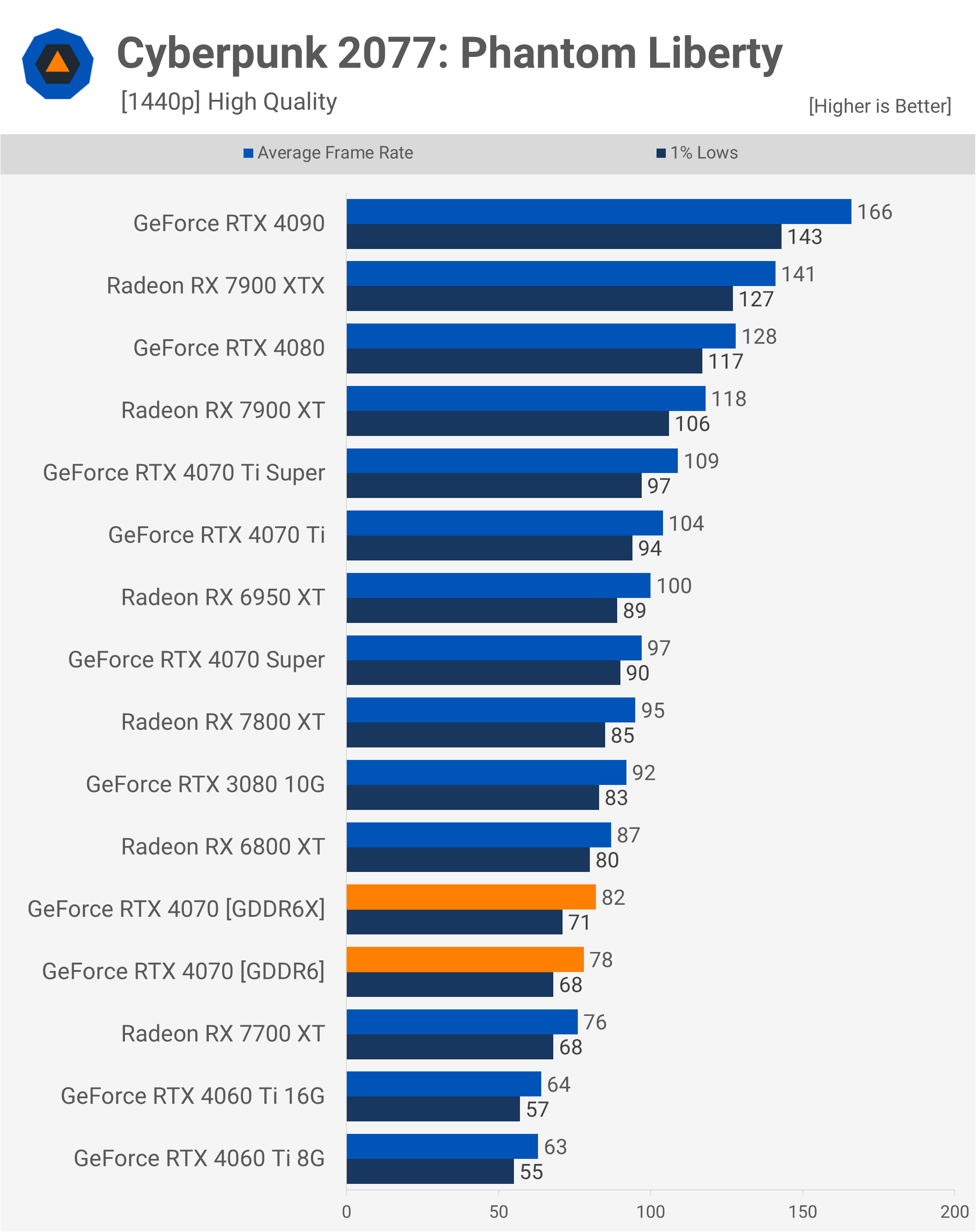
In Cyberpunk 2077 Phantom Liberty at 1440p, we’re seeing a 5% performance reduction – this is the largest performance drop in any of the benchmarks, spoiler alert. As a result, the RTX 4070 is now just 3% faster than the much cheaper 7700 XT.
Dying Light 2
We observed a 4% reduction in Dying Light 2, dropping from 89 fps on average to 85 fps. While it’s a small reduction, it does mean that the RTX 4070 is now slower than the 7800 XT.
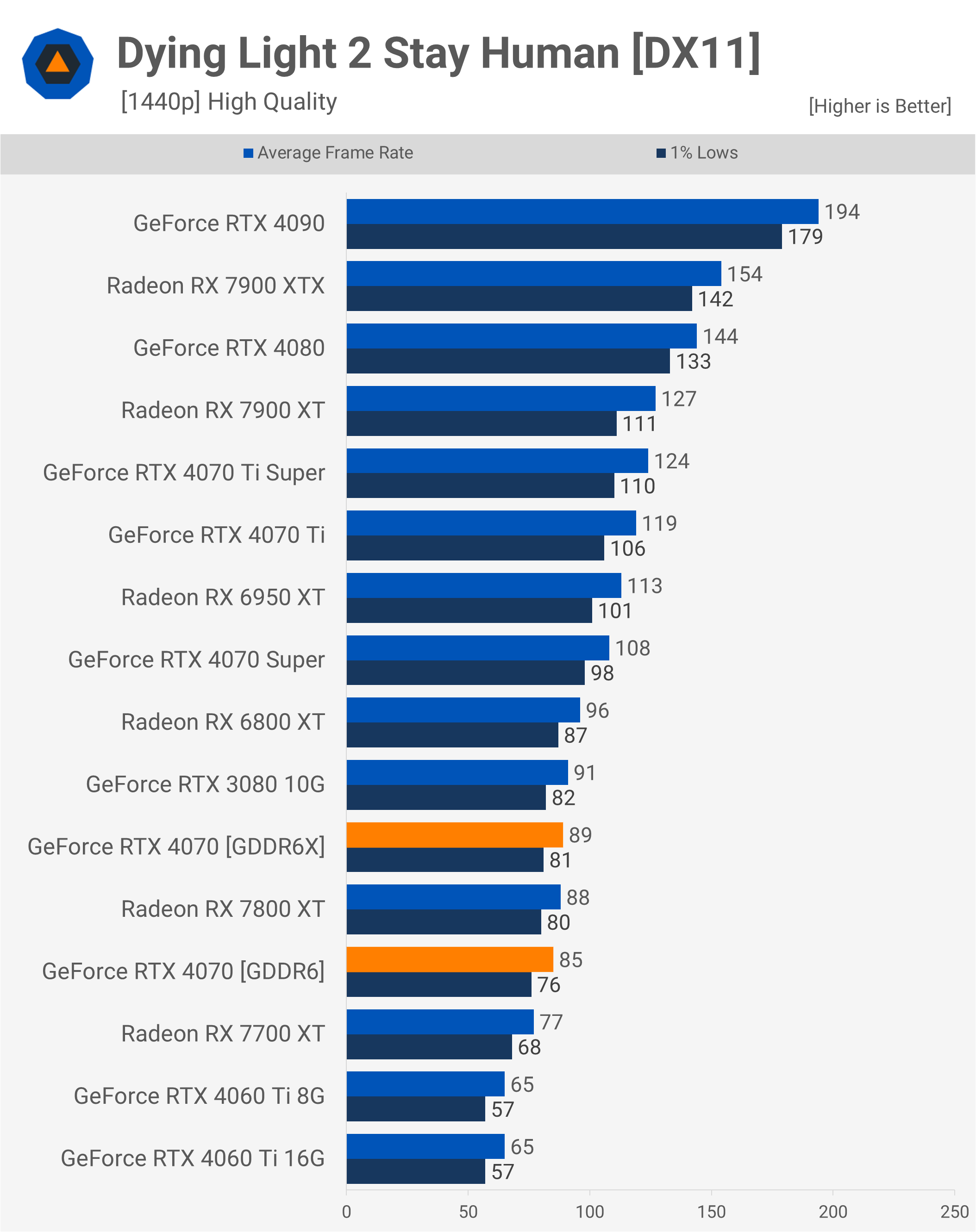
A Plague Tale: Requiem
Finally, in A Plague Tale: Requiem, we see another 4% reduction in performance, dropping from 81 fps to 78 fps – a loss of just a few frames. Once again, this moves the RTX 4070 closer in performance to the much cheaper 7700 XT.
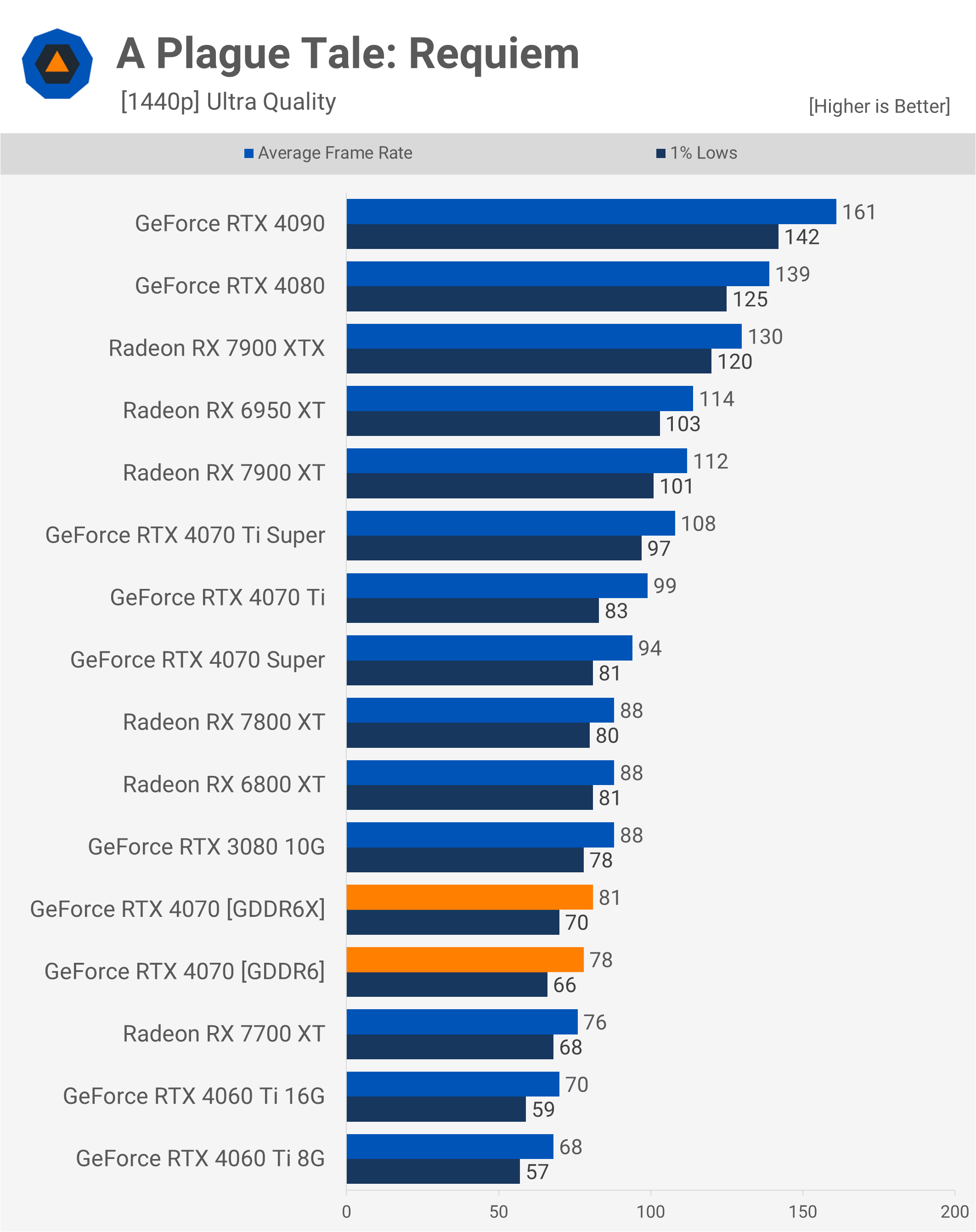
Average Performance
At 1080p, we observed an average 4% performance reduction, making the GDDR6 version of the RTX 4070 just 6% faster than the 7700 XT, despite costing over 40% more. This is a concerning gap in value.
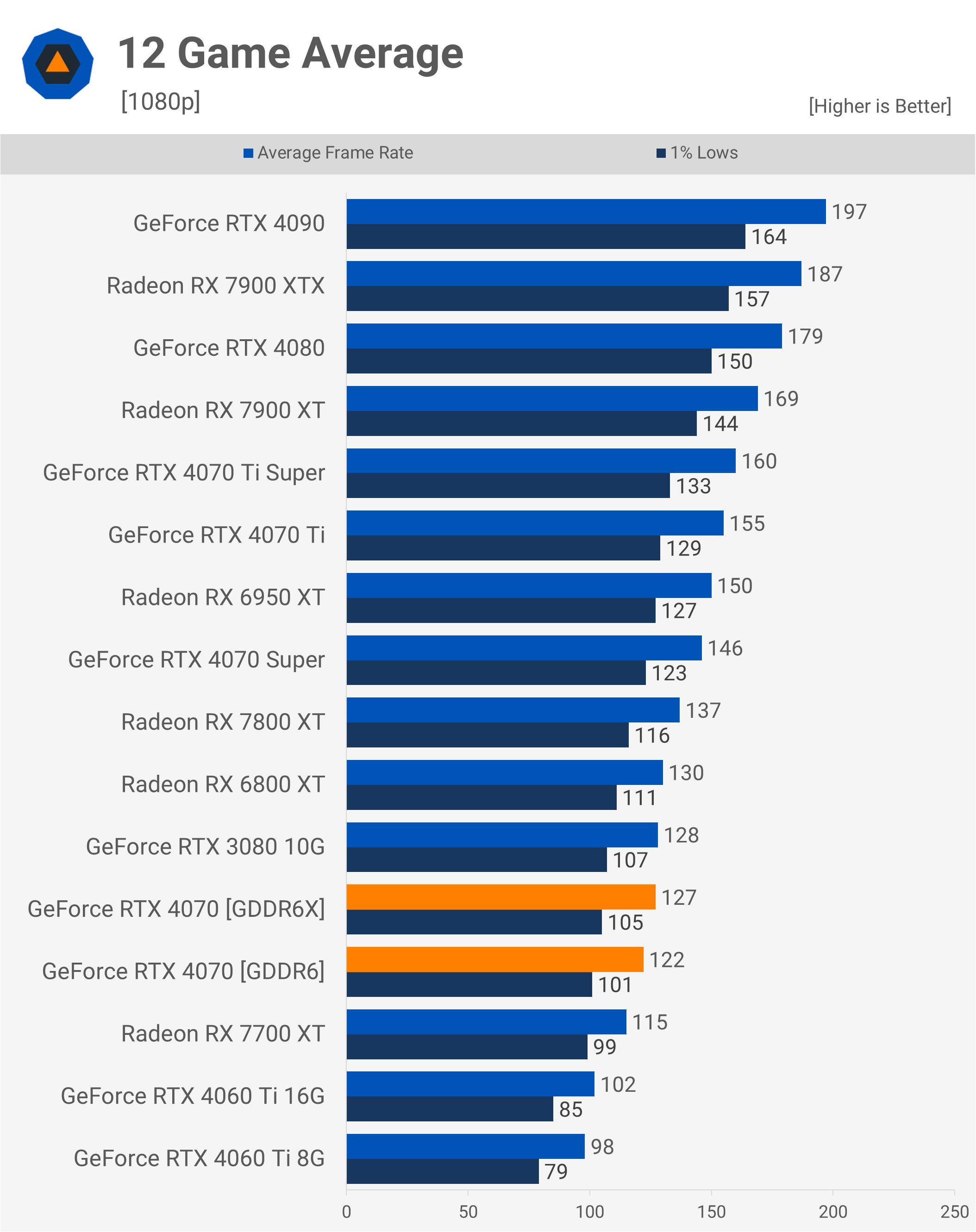
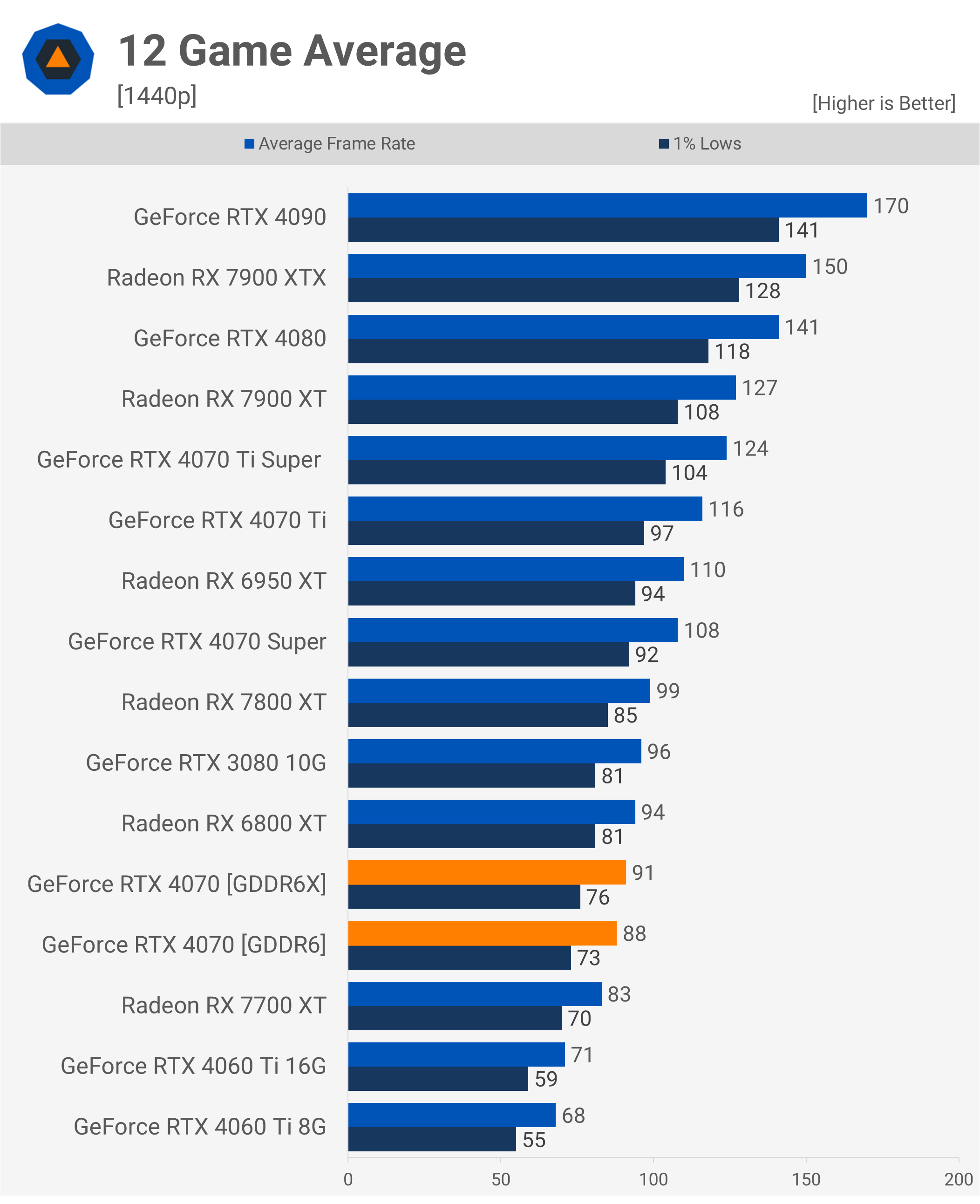
At 1440p, the GDDR6 version saw just a 3% performance drop compared to the original, but again, this brings it closer to the performance of the 7700 XT.
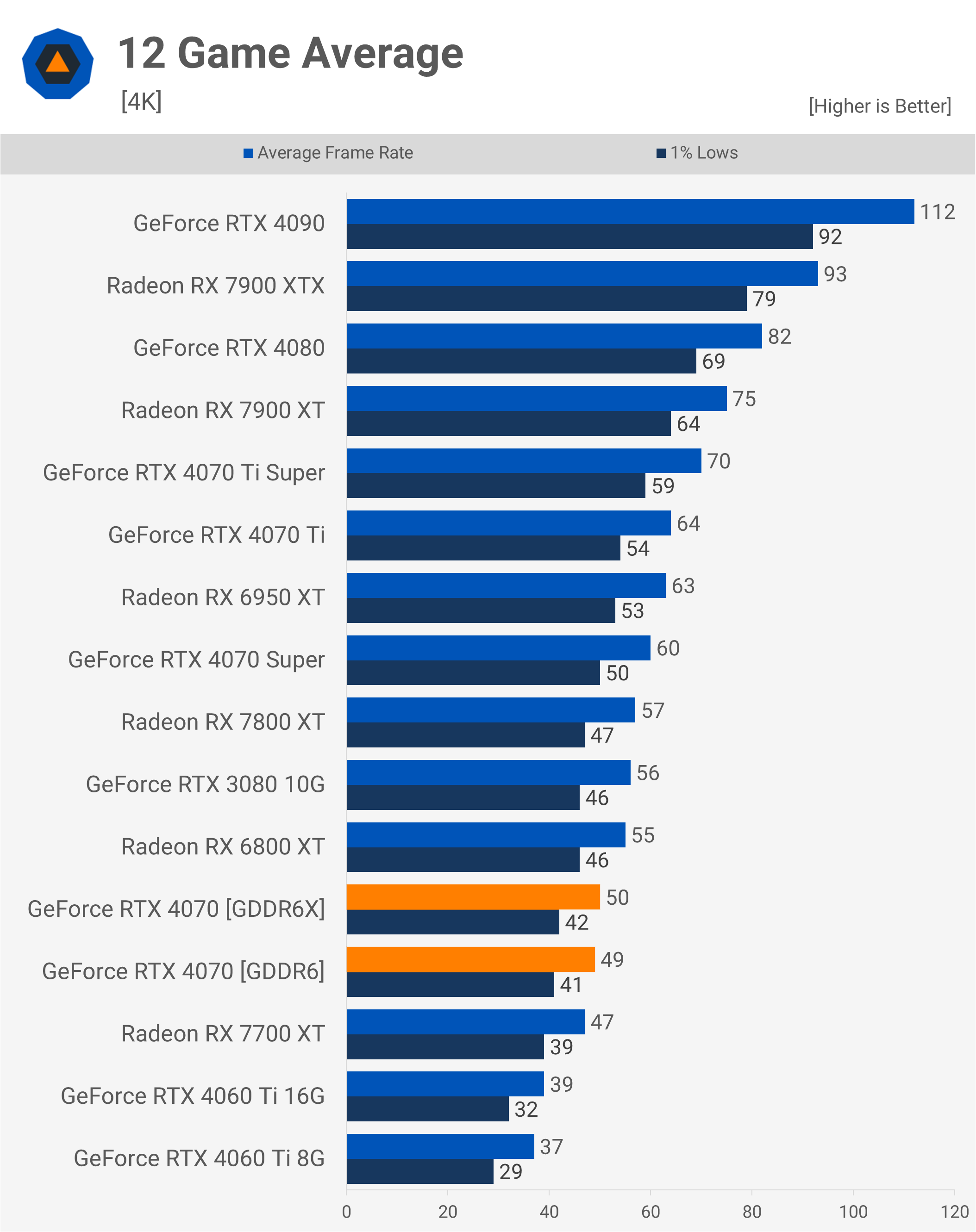
At 4K, we see only a 2% reduction in performance, as memory bandwidth is no longer the primary bottleneck at this resolution.
Power Consumption
For those interested in power usage, when looking at total system power consumption, the Gigabyte OC model consumed a few watts less than the Founders Edition model, but it also produced a few fewer frames. In short, power consumption remains very similar between the two.
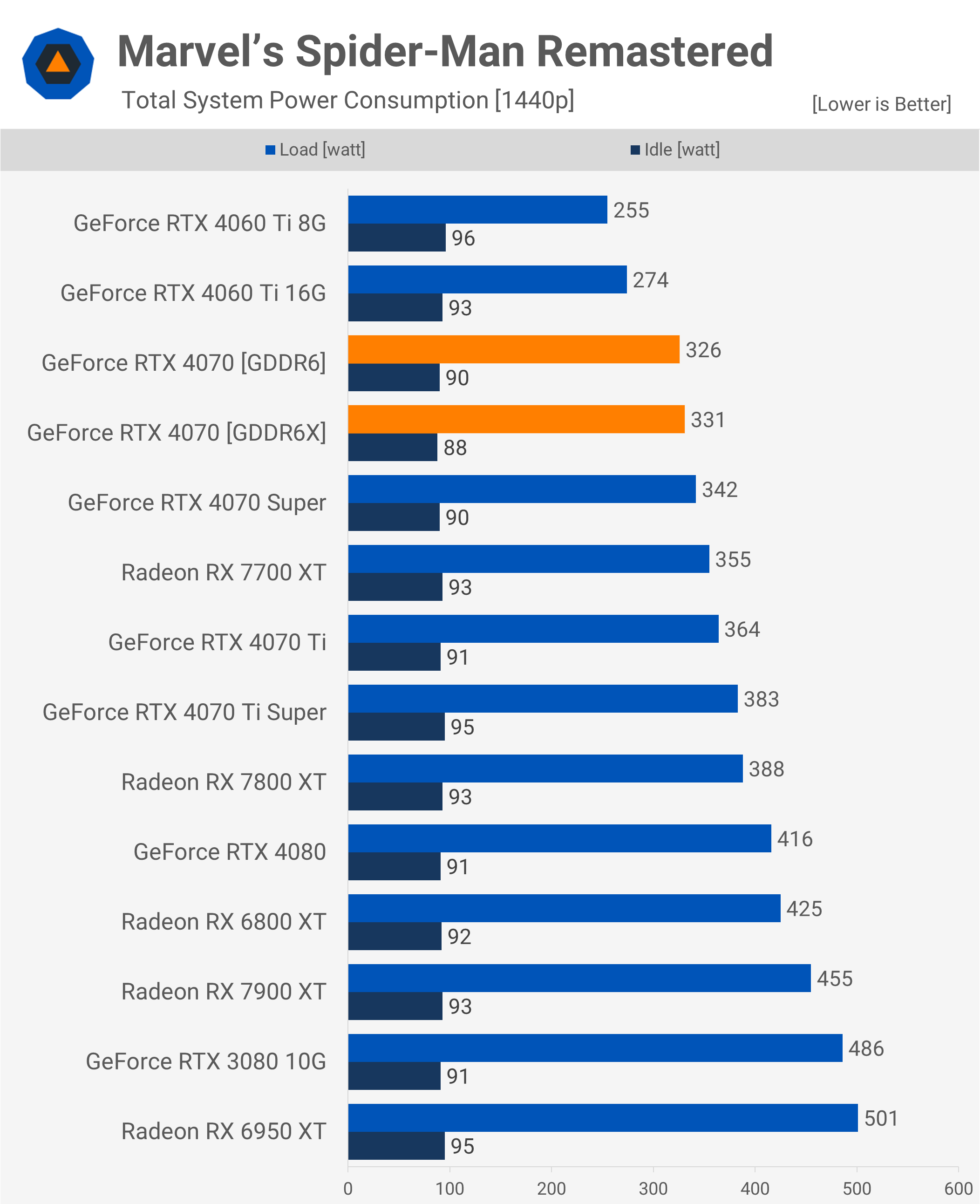
What We Learned
The good news is that the RTX 4070 GDDR6 isn’t much slower, as expected, given we’re only seeing a 5% reduction in memory bandwidth. The bad news, however, is that it is still slower. While those who buy the wrong model aren’t facing a dramatic performance drop, they are still losing out on some performance.
After all, many are willing to pay a small premium for OC models that offer only 2-5% more performance out of the box, so paying the same amount for 2-5% less performance is unlikely to sit well with many.
In fact, we weren’t sure how upset we should be about this move from Nvidia. Our initial reaction to situations like this is usually quite negative – it just rubs us the wrong way. To put it bluntly, it’s pisses me off. Nvidia advertised the RTX 4070 with 21Gbps GDDR6X memory, and that’s what it should have. If availability becomes an issue, Nvidia should either discontinue the product or re-release it under a new name.

So, on behalf of consumers everywhere, we were frustrated. This is yet another anti-consumer move by Nvidia. But before going on a full-blown rant about how bad the GDDR6 version of the RTX 4070 is, we thought we’d ask the community what they think. After all, if no one cares, should we even bother?
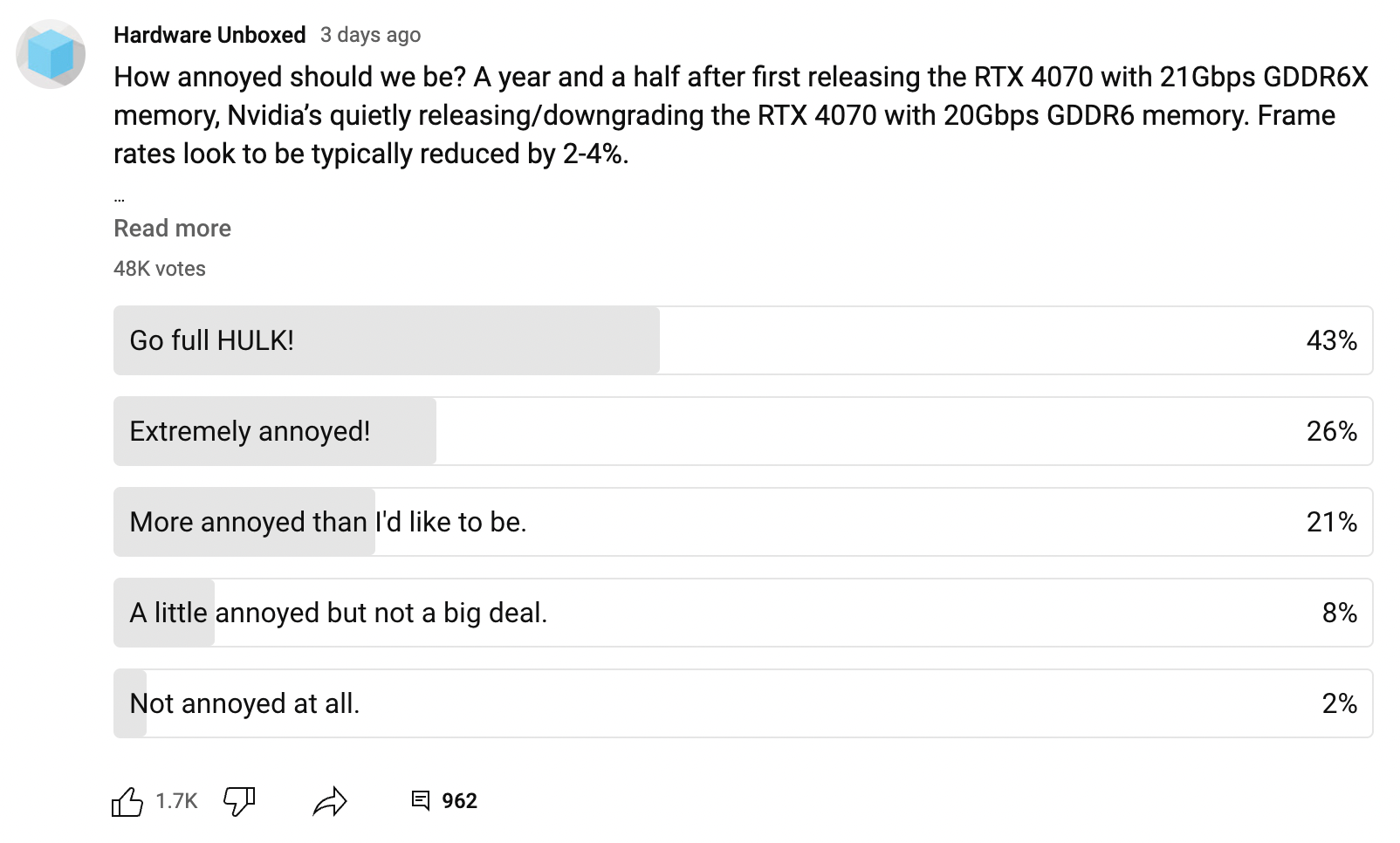
A few days ago, we ran a poll on the HUB community tab, asking how annoyed we should be with this situation. About 70% of you said we should be ‘extremely annoyed,’ with a further 20% saying ‘more annoyed than you’d like to be.’ In fact, only 8% said they were ‘a little annoyed, but it’s not a big deal,’ and a mere 2% claimed they were ‘not annoyed at all.’
We made it clear that performance had only regressed by 2-4%. So, with all the facts on the table, it’s evident that the overwhelming majority of you are frustrated with Nvidia’s move – and rightly so. The fact that both models carry the same name, and it’s unclear which version is which, is a major issue.
Most people don’t know whether the RTX 4070 is supposed to come with GDDR6 or GDDR6X, or that two versions even exist. To make matters worse, the GDDR6 version costs the same as the GDDR6X version.
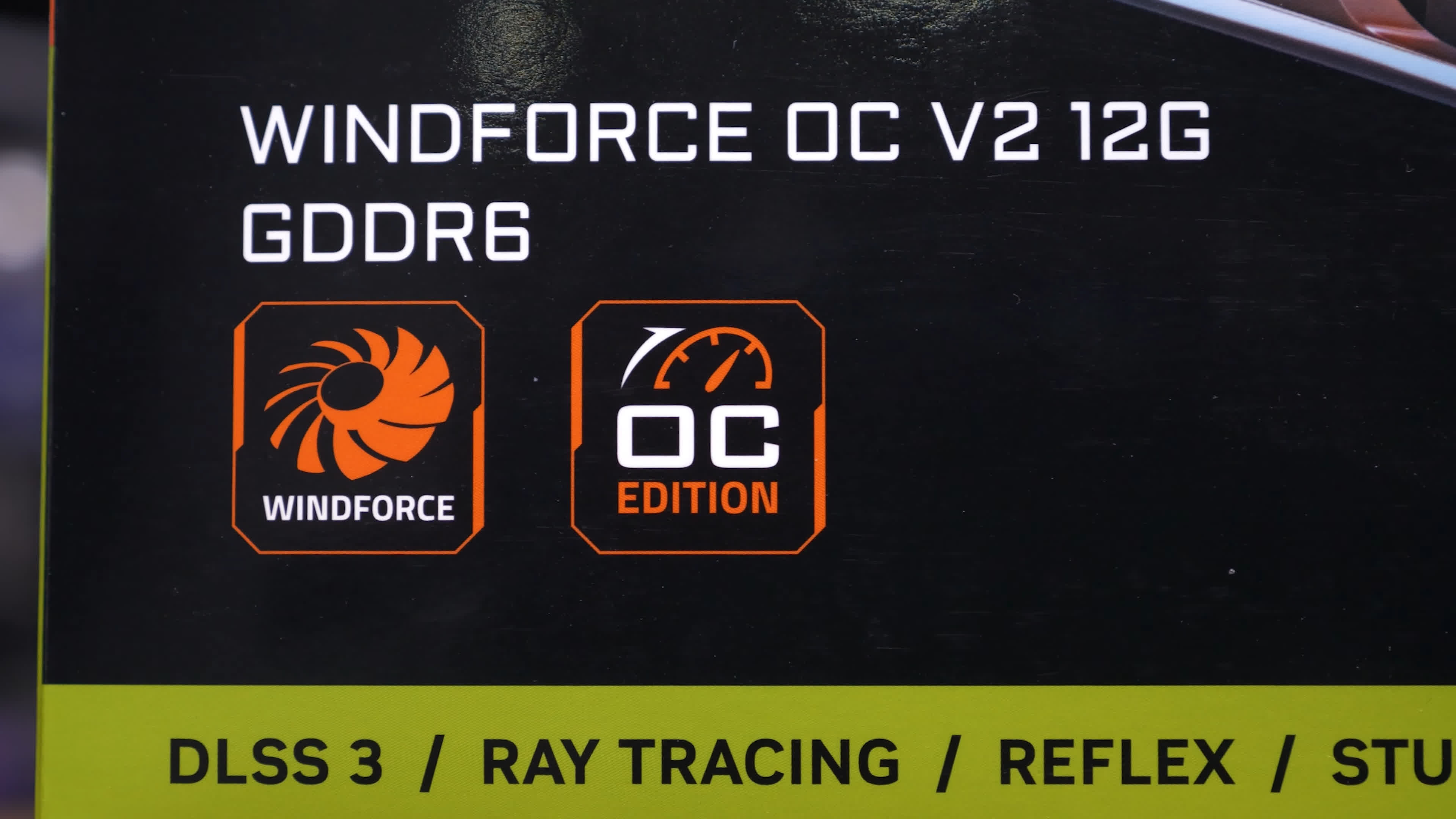
It’s not like Nvidia is offering a discount to those who end up with the GDDR6 version – they’re simply providing a cheaper-to-produce product and pocketing the difference. The only silver lining, in our opinion, is that Nvidia isn’t misleading consumers as severely as they did with the GT 1030.
We are fairly confident that what Nvidia is doing here could be considered illegal in some regions, but they’ve been using these bait-and-switch tactics for years without repercussions. So, we expect them to continue doing so in the future. And to be fair, it’s not just Nvidia – though the worst examples tend to involve GeForce products. AMD has also misled customers with dodgy product names, as we’ve seen recently with the Ryzen 7 5700. So, we’re not just singling out Nvidia here.
Shopping Shortcuts:
- Nvidia GeForce RTX 4070 on Amazon
- Nvidia GeForce RTX 4070 Super on Amazon
- AMD Radeon RX 7800 XT on Amazon
- Nvidia GeForce RTX 4070 Ti Super on Amazon
- AMD Radeon RX 7900 XT on Amazon
- Nvidia GeForce RTX 4080 Super on Amazon
- AMD Radeon RX 7900 XTX on Amazon


